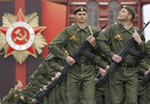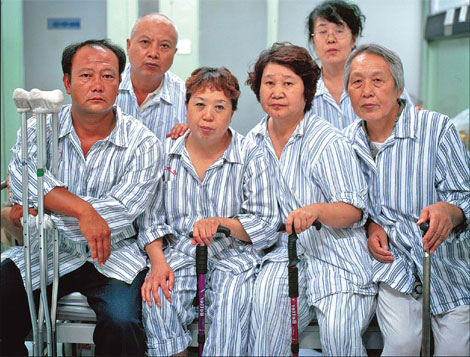Society
Living with SARS
Updated: 2011-03-28 08:02
By Yi Lin (China Daily)
|
Victims of SARS (from left to right) Wang Baozhen, Zhang Jinping, Cao Baozhen, Bao Baoqin, Li Chaodong and Wang Ligang, receive treatment at Wang Jing Hospital for femoral head necrosis. Photos by Zhang Lijie / For China Daily |
In late 2002 the world was shaken by SARS. The battle to contain the virus owes a debt to those who risked their health so others could live, but as a result were scarred for life. Yi Lin from China Features reports.
For many, the Severe Acute Respiratory Syndrome (SARS) epidemic that killed more than 300 people and infected hundreds of others on the Chinese mainland in 2003 has faded from memory. But not for photographer Zhang Lijie.
Since 2006, the 30-year-old has recorded the desolate world of SARS survivors, who are still suffering from the side effects of treatment that saved their lives.
Zhang has taken more than 13,000 photographs of these survivors, left with permanent bone and lung damage, and of Xiaotangshan Hospital, the temporary medical center built in a north Beijing suburb for SARS victims.
There are pictures of a widow holding up a photograph of her dead husband; of two young women undergoing treatment in a hot spring pool for osteonecrosis, a wasting bone disease; and of dust-covered documents, beds and alcohol burners at Xiaotangshan.
"I want to bring these 'invisible people' to light so they can receive help," Zhang says.
In spring, 2003, she was working on a master's degree in journalism when the virus spread rapidly on the Chinese mainland. Beijing, her hometown, was the center of the epidemic, with more than 1,000 cases.
"The first thing that comes to mind is the long, forced holiday. College was shut down out of safety concerns in April that year," Zhang recalls. "My family and I were quarantined and it was boring."
She invited one of her classmates, from Anhui province, to stay with her till college reopened in June.
"We were away from the center of all the chaos, so to some extent, what were fearful days for many were quite peaceful for us," she says.
However, tension built up nationwide as the number of infections and deaths climbed.
According to a WHO report on Aug 15, 2003, more than 5,000 people were infected on the Chinese mainland, with the final death toll hitting 349.
Patients and even their families were widely discriminated against, as fear and panic spread.
"It was tortuous to see the death toll mounting on TV, but it was even worse to think that this new killer was a total mystery," Zhang says.
"SARS remained a mystery to me, even after the government announced that it had won the battle against it."
E-paper

War of the roses
European Chinese rose growers are beating their Chinese rivals at their own game
High-tech park gets big boost
At the source
Merchant of Venice
Specials

Sino-US Dialogue
China and the US hold the third round of the Strategic and Economic Dialogue on May 9-10 in Washington.

Drunk driving
Drunk drivers face a detention for one to six months and a revokation of their drivers' license.

V-Day parade
A military parade marking the 66th anniversary of the Soviet victory over Nazi.

